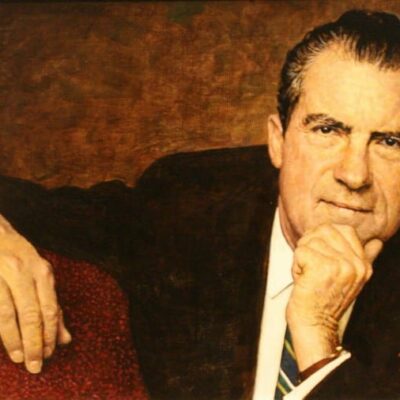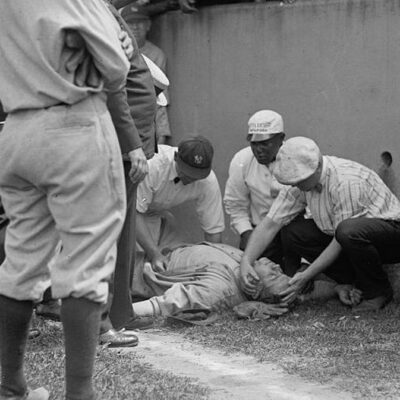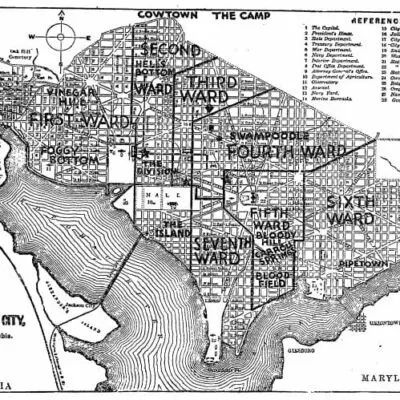GoDC buddy Wayne has kindly requested some digging into the story of the “hobbit homes” on V St. NW. We’re happy to oblige as we are quite curious of their origins. So, this will be a unique “If Walls Could Talk” for GoDCer Wayne.
The homes we are investigating are situated about two blocks from 18th and U St. NW. If you’ve ever walked by them, you know what we’re referring to. There are five homes on V St. NW (1730 to 1738), three on 17th St. NW (2100 to 2104) and three more on Florida Ave. NW (1700 to 1706).
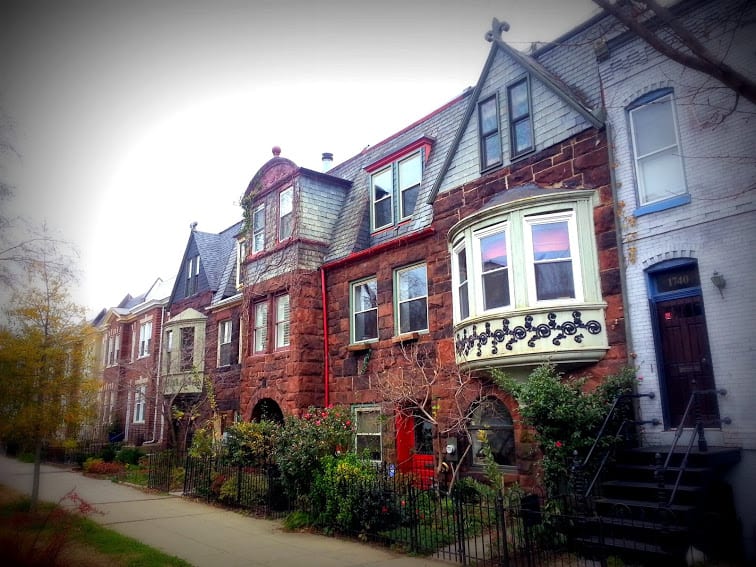
Now, we have heard the theory that they are somehow connected to the old Boundary Castle (i.e., on top of Meridian Hill where Beekman Place stands today). But, after hours of exhaustive digging through material, we were unable to find a direct link between the two. The only thing currently tying them together is their location and the Seneca sandstone used to construct them. (If anyone can provide the documented evidence, please share it with us).
Also, we should add that, we found several of the servants who worked at the Henderson family’s massive home in the U.S. Census as well as the city directories of the time, some in homes that obviously no longer exist. Claudia Webb, maid, Edward Bennett, chef, William Carter, chauffeur, Pierre Bertheau, chef, George Fowler, coachman and Valerie Vidal, governess — are you feeling like this is Dowton Abbey? — all were listed as living either at 1601 Florida Ave. or 2200 16th St. NW (i.e., the castle).
It should also be added that odd numbers are on the north side of the block, so possible it was another building or just another address for the castle.

So, since they aren’t linked, what’s the story behind them?
First, let’s share with you a map of the area. Below is the 1903 Baist real estate map of Boundary St. (i.e., Florida Ave.), V St. and 17th St. to the right. The city squares are marked 149 and 150 (the larger one).

You will notice that a number of the homes in the area had already been built, including the ones we are looking into. They are marked as lots 240 to 244 on V St., and lots 1 to 7 in square 149 (lot 5 is still undeveloped today). It’s also neat to see all the homes on U St. (lots 245 to 273) are also built up by 1903. Any GoDCer happen to know someone who lives in one of the houses shown above?

Okay, back to the story … the square and lot numbers appear to change hands a number of times in the late 19th century. Square 149 appears to have been subdivided by Jesse D. Gibbs and square 150 by two men, Boughton and Moore.
On September 20th, 1891, the Sunday Herald reported that lot 149, in its entirety, was sold by J. H. Gulick to Rebecca N. Burrhus for $7,443. Evidently her husband Fred was a Member of Congress.
On October 3rd, 1891, the Washington Post published the following report about new building permits.
E. D. Frazier, seven two-story brick dwellings, 1700 to 1706 Florida avenue and 2100 to 2104 Seventeenth street northwest, $14,000.
So, the homes in square 149 appear to have begun construction in 1891 and, what’s interesting, is that 1706 Florida Ave. (i.e., lot 5) doesn’t appear to be standing any more.
The Ghosts of D.C. theory is that he designed the homes with facades to mimic the Romanesque design of Boundary Castle (completed in 1888) in order to attract people to the developing far reaches of the city.
A little more on Ernest D. Frazier … he was a carpenter, builder and architect, originally from Frederick, Maryland. He and his family lived at 1621 15th St. NW (15th and Q).

On November 1st, 1892, J.R. Taylor purchased lot 7 (2102 17th St.) from N.K. Earle for $6,000 with the newly built home, measured at 15 by 36 feet. Unfortunately, we weren’t able to dig anything up on these two.

However, we did track down a number of other real estate transactions involving these homes, as well as classified ads mentioning them.
Here is a notice in the Evening Star on March 7th, 1894 for an auction to be held for lot 4 of square 149 (1704 Florida Ave.).

A similar auction was held for 2100 17th St. NW. The following article was listed in the Washington Post on Saturday, May 5th, 1894.

On May 19th, 1894, an advertisement ran in The Evening Star to rent part of 1704 Florida Ave.
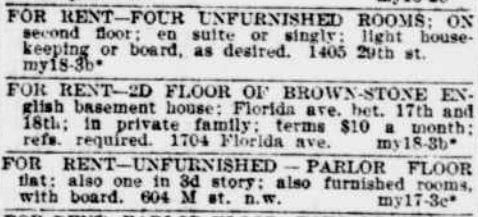
Now, this is where it gets interesting and Wayne will be blown away.

An article in the Washington Post on April 23rd, 1897 reported on the assignment of property to a widow.
Justice Hagner, in Equity Court No. 2, yesterday entered a decree assigning the dower of Helen Douglass, widow of the late Frederick Douglass, giving her all of lot 150 in Boughton and Moore’s subdivision of lots in square 150, and the improvements thereon. She also receives by the decree a parcel of land containing nine and one-quarter acres in Anacostia and other property in Chichester, the title to the property being vested in Mrs. Douglass during her lifetime. The widow instituted suit some time ago against Rosetta D. Sprague and others, heirs of the late Frederick Douglass, claiming dower, with the result that the decree of yesterday was ordered.
Go back up to the map above and you can see how large square 150 is. We were blown away when we read that article … not what you expect to uncover.
On Wednesday, April 24th, 1901, The Evening Times included a classified ad from the resident of 1704 Florida Ave., apparently occupied at the time by a tailor.

Here’s a transaction for the “hobbit house” on V St. This is from the Washington Post on January 8th, 1902.
Square 150–American Security and Trust Company to James M. Carroll, jr., $10, lot 240, Johnsons’s subdivision.
Really, $10? That’s ridiculous.
Another interesting real estate transaction for square 150 was for lot 153, not one of the homes we’re looking at but it was sold by Lewis Douglass, Frederick’s son. This was in the Washington Post on March 31st, 1908.
Square 150–Lewis H. Douglass et ux. to Richard E. Pairo and Herbert A. Gill, to secure John J. Brosnan, $3,000, 3 years, 6 per cent, semiannually, lot 153.
In 1913, the home at 1702 Florida Ave. was available for rent, unfurnished, by Paul V. Mitchell & Co. Take a look at the advertisement below. The going rate was $22.50 per month (that wouldn’t even pay your water bill today). The home was designated for African Americans.

The Washington Herald reported on October 22nd, 1920 that lot 6 (2104 17th St.) was purchased for $1,850 by George W. Jackson using a mortgage at 6% interest. It stated that there were “monthly payments,” so we assume the monthly payment of $1,850 was for a brief period of time until it was paid off. The home was likely valued somewhere in the range of $15,000 by then.
Hopefully, when you’re walking by these homes now, you’ll have a little different perspective on them.





